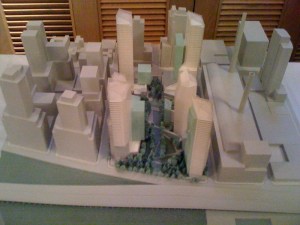Upper West Side’s Final Frontier! Community Board Scrutinizes Riverside Center
 After decades, the final chapter of the Trump City development saga is now taking shape with the first rounds of debate under way at the most local level of public review.
After decades, the final chapter of the Trump City development saga is now taking shape with the first rounds of debate under way at the most local level of public review.
Tuesday night’s Community Board 7 meeting featured a lengthy session on the final parcel of the massive Riverside South development—an assortment of apartment buildings along the Hudson River, first planted by Donald Trump over two decades ago. Not surprisingly, public school space, affordable housing, and density were hot-button issues at the hearing, which trudged along for hours in a downstairs, weakly air-conditioned room in the Congregation Rodeph Sholom on 83rd Street.
Riverside Center—developer Extell’s 8-acre mixed-use project on the southwest corner of the Upper West Side—is the remaining undeveloped plot of land in the neighborhood, and it is now working its way through the city’s seven-month rezoning process, which started in May.
The local community board, after facilitating several hearings, will vote on its non-binding recommendation on July 22. The development will ultimately have to go through the City Planning Commission and the City Council.
“It will be a mixed-use project with tangible benefits to the community and the city,” Extell executive vice president Anthony Mannarino told the crowd, citing new job opportunities and the design’s open spaces.
“We started by developing a master plan that integrates buildings and the landscape,” Stephen Hill, an architect with Extell, added. “We know this piazza will be welcoming to the entire neighborhood.”
The hearing, explained Ethel Sheffer, chairperson of the Riverside Center Working Group, was designed to offer the public and board members an opportunity to critique the “core principles” that CB7 has thus far identified, including, public education, housing, sustainability, traffic, density and streetscape. With overcrowding in the local school district increasing, many board members and residents expressed concerns about the developer’s commitment to school space.
Extell has agreed to fund part of the construction of 75,000 square feet of school space in one of its buildings to help mitigate the effects of a rapid influx of families with children.
The developer will fund the construction of the “core and shell” of the school (which Helen Rosenthal, CB7 member and former chair, explained to The Observer, refers to “skin and bones, like mechanical and plumbing” of the school space), and then the Department of Education has to fund the “fit-out” (the rest of the internal infrastructure).
For families and education advocates concerned about overcrowding, this is a weak commitment.
“Let’s not keep putting band-aids on a gaping wound,” said Varda Steinhardt, a parent from P.S. 87, an Upper West Side school, which she said has already experienced a 60 percent increase in kindergarten applications over the last three years.
“It’s obviously put a great strain on the entire community,” added Rachel Laiserin, the co-president of the school’s Parents Association.
Along with the funding for “core and shell” construction, Extell is making available an additional 75,000 square feet that the School Construction Authority could choose to utilize for school space.
But in order to offer that maximum 150,000 square feet entirely for public education, the D.O.E would have to fund the “fit-out” construction of the first half, and the entire construction of the second half. “It’s a half of a half of a school” the developer is offering, Ms. Rosenthal told The Observer. “We have to list this as a top priority,” she said, urging that the developer fund in full the construction of 150,000 square feet of school space.
But Paul Selver, co-land-use counsel for the developer, told The Observer after the hearing that Extell is doing everything it is required to and should not have to invest further funds into school space. “The basic principle of land-use regulation is if you have an impact, you pay for it,” he said. “Anything more than what we’re doing would be unconstitutional.”
Others complained that the 12 percent affordable housing commitment by the developer is low.
Sheldon Fine, a former CB7 chair, urged 20 percent.
Mr. Mannarino from Extell said that the developer is “currently in discussions with HPD [Housing Preservation and Development] and the city to increase this commitment.” (City Planning Commissioner Amanda Burden, in an unusual stance this early in the process, recently signaled that Planning would like to see more affordable housing brought into this development.)
Assemblymember Linda Rosenthal told The Observer that she wanted more affordable housing, but was optimistic. “You don’t usually hear this kind of thing from City Planning. I think that’s a hopeful sign,” she said. The assemblywoman, remembering when the Restrictive Declaration for Riverside South first passed in 1992, added that it’s about time this project moves forward.
“I remember thinking, ‘O.K., good, the issue is almost done.’ Now, it’s 2010, and we’re still working on it,” she said. “It’s crazy.”
slevin@observer.com


